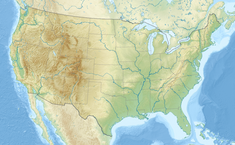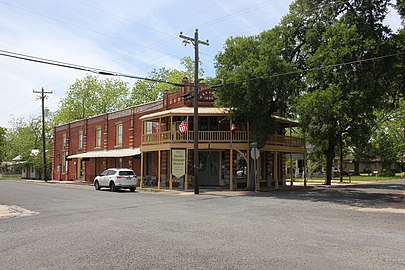
The Wilson Building is an historic 8-story building in the Main Street district of downtown Dallas, Texas. The building was completed in 1904 and patterned after the Palais Garnier in Paris, France. The historic structure fronts Main Street on the south, Ervay Street on the east, and Elm Street on the north. The Wilson building was the tallest structure in Dallas from 1904–1909 and was considered the premier commercial structure west of the Mississippi. The Wilson Building is situated across from the flagship Neiman Marcus Building and is adjacent to the Mercantile National Bank Building.
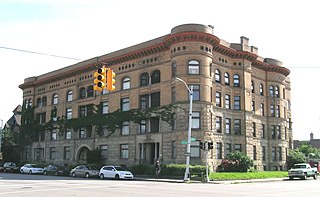
The Coronado Apartments are an apartment building located on 3751–73 Second Avenue in Midtown Detroit, Michigan. It was designated a Michigan State Historic Site in 1980 and listed on the National Register of Historic Places in 1982.

The Wilbraham is an apartment building at 282–284 Fifth Avenue and 1 West 30th Street in the Midtown South neighborhood of Manhattan in New York City. The nine-story structure was designed by David and John Jardine in the Romanesque Revival style, with elements of the Renaissance Revival style, and occupies the northwestern corner of 30th Street and Fifth Avenue. It was built between 1888 and 1890 as a bachelor apartment hotel. The Wilbraham is a New York City designated landmark and is listed on the National Register of Historic Places.

Ten Sleep Mercantile, also known as Ten Sleep Hardware, is an example of a typical small-town general store. Located in Ten Sleep, Wyoming, it has been the focal point of the town since it was built in 1905 by H.T. Church. Upon Church's death in 1918 the property was bought by Buffalo businessman and rancher Alex Healy (Rancher) in an agreement that brought the store under the control of Paul Frison. Frison, who later served as mayor of Ten Sleep and as a Wyoming state legislator, operated the store from 1918 to 1943.

The Henry Berg Building is a historic building located in downtown Davenport, Iowa, United States. It has been individually listed on the National Register of Historic Places since 1983. In 2020 it was included as a contributing property in the Davenport Downtown Commercial Historic District.
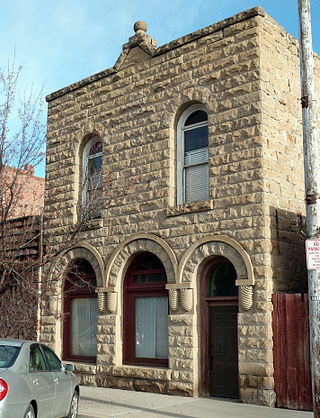
The First Bank of Vale is a historic building located in Vale, Oregon. It was built in 1901 from completely from locally quarried native stone by local pioneers, the Hope brothers. The compact two story building is vernacular architecture of the Richardson Romanesque style. It was listed on the National Register of Historic Places on 5 March 1992.

The H. A. McKim Building is a historic building located at the southwest corner of Main and Oddie Streets in Tonopah, Nevada. The building was constructed in 1906 for Hiram Albert McKim, who had begun a mercantile business in the town two years prior. Carpenter craftsman J. J. Finley and stonemason E. E. Burdick constructed the building, a two-story stone building designed in the Classical Revival style. The building's design includes an ashlar front facade, a pediment at its parapet, second-story windows ornamented with voussoirs and keystones, and a metal cornice. McKim's store ultimately became the largest mercantile store in central Nevada.

Fayetteville Historic District is located in Fayetteville, Texas. The small town of Fayetteville is in rural south east central Texas midway between Houston and Austin. The oldest extant building in the district was constructed in 1853. The historic district represents most of the development within town boundaries as indicated by street signs, the boundaries have been drawn to exclude some areas in town occupied primarily by construction from after 1958. The area of the district is 153.5 acres (62.1 ha) and includes 345 properties considered historical and largely intact. An additional 137 properties within district boundaries are not considered for contribution to the historic status of the district. It was added to the National Register of Historic Places (NRHP) on July 10, 2008.
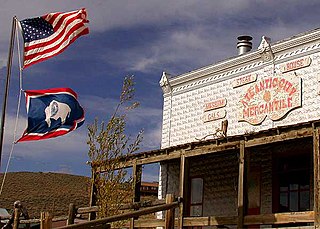
Atlantic City Mercantile is a former store now used as a bar and restaurant in Atlantic City, Wyoming. It is one of the chief buildings in the small mining town in the South Pass area of Wyoming, and is a significant example of a late 19th-century commercial building on what had recently been the frontier.

Freese's Tavern is a historic tavern and general store at 1011 Whittier Highway, the northwest corner of the junction of New Hampshire Routes 109 and 25 in Moultonborough, New Hampshire. With a building history dating to about 1780, and a continuous history of operation as a tavern, general store, post office, library, and town hall, it is one of the oldest establishments of its type in the United States. It is presently known as The Old Country Store, and includes museum displays on its history. The building was listed on the National Register of Historic Places in 1982.

The Wakefield Town Hall and Opera House is a historic municipal building at 2 High Street in the Sanbornville village of Wakefield, New Hampshire. Built in 1895, it is a prominent local example of Romanesque architecture, and has housed civic and social activities since its construction. The building was listed on the National Register of Historic Places in 2007, and the New Hampshire State Register of Historic Places in 2002.

The Gale Memorial Library is the public library of Laconia, New Hampshire. It is located at 695 Main Street in a Richardsonian Romanesque building, whose 1901–03 construction was funded by a bequest from Napoleon Bonaparte Gale, a local banker. The building was designed by Boston architect Charles Brigham, and is listed on the National Register of Historic Places.

The K. J. Taralseth Company was a prominent retail business in Warren, Minnesota, United States, in operation 1888–1959. The original building it occupied burned down in 1910, so the owners commissioned a new building the following year which is still standing. Both facilities contained the department store as well as space for other tenants—including a Masonic temple—and hosted numerous community events. The 1911 building in which the K. J. Taralseth Company was housed for almost half a century was listed on the National Register of Historic Places in 2002 for having local significance in the theme of commerce. It was nominated for representing a business and a venue that served a central role in the life of the community.

The Starling Grange, now Starling Hall, is an historic former Grange hall at 2769 Main Street in Fayette, Maine, US. Built in 1879, it has been a fixture of the community since then. The Grange chapter disbanded in 1987, and the building has since then been owned by the town. It was listed on the National Register of Historic Places in 2016.
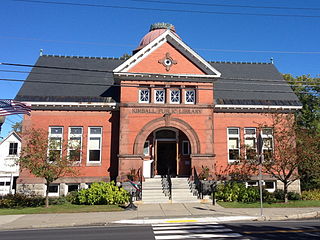
The Kimball Public Library is the public library serving Randolph, Vermont. It is located at 67 Main Street, just north of the town center, in an architecturally distinguished building donated by Col. Robert Kimball, a Randolph native. Built in 1902, it was listed on the National Register of Historic Places in 1985.

The Stockgrowers Bank, also known as the Dixon Town Hall, was built in Dixon, Wyoming in 1916. The decorated concrete masonry building was the bank's headquarters until the bank was dissolved in 1923. Following the bank's demise the building served as a soda fountain into the 1940s, which was followed by a store, then the Little Snake River Veterans of Foreign Wars Post 10051 hall. In 1975 it became the town hall.

The Kahlert Mercantile Store is a historic commercial building in Browerville, Minnesota, United States. It was built in 1883 as Browerville was springing up around a newly built railroad line. The simple wooden building with a false front contained retail space on the ground floor and a community meeting hall upstairs. The building was listed on the National Register of Historic Places in 1985 for having local significance in the themes of commerce and exploration/settlement. It was nominated for being a highly intact example of the vernacular commercial architecture erected in Minnesota's railroad boomtowns.
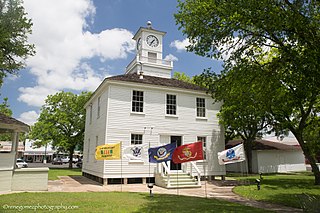
Fayetteville County Precinct No. 2 Courthouse is a historic building located in Fayetteville, Texas.

The Fayette County Courthouse Square Historic District in La Grange, Texas is a historic district roughly bounded by Main, Lafayette, Franklin, Colorado, Jefferson, Washington, and Crockett Streets. It was listed on the National Register of Historic Places on January 16, 2001. Two notable buildings in the district are the Fayette County Courthouse and Jail. Forty–seven buildings, three structures and four objects were identified as contributing to the historic nature of the district.
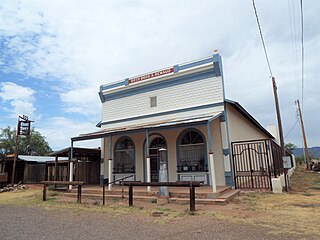
Pearce General Store is an historic building in Pearce, Arizona. It was added to the National Register of Historic Places in 1978.


